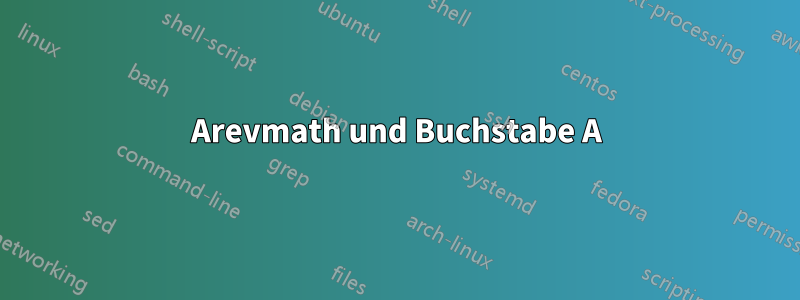
Das arevmathPaket bietet zwei verschiedene a, verfügbar als \origa und \vara (Standardwert). Wenn man jedoch \DeclareMathSymbol{a}{\mathalpha}{extraitalic}{50}in der Präambel hinzufügt, dass \origa als Standard-a festgelegt wird, ist die Ausgabe falsch; z. B. ergibt $\mathsf{a}$ 2, dasselbe gilt für $\mathbf{a}$.
\documentclass{article}
\usepackage{arevmath}
\DeclareMathSymbol{a}{\mathalpha}{extraitalic}{50} % \origa by default
\begin{document}
$a, \mathsf{a}, \mathbf{2}, \vara, \origa, \mathsf{\origa}$
\end{document}
Wie kann ich das beheben?
Antwort1
Ältere Schriftarten mit lediglich 128 oder 256 Steckplätzen erforderten viel Programmieraufwand und viele Schriftarten-Unterstützungsdateien.
Für arevmathPakete akönnten die fettgedruckten tt und tt das Richtige für Sie sein. Ansonsten ascheint „rund“ die Norm zu sein.
Schneller Überblick:
(Mit dem Paket ist es allerdings einfacher, ttf\otf-Schriftarten zu verwenden unicode-math.)
MWE
Schrifttabellen / Glyphenlisten:
\documentclass{article}
\usepackage{arevmath}
\usepackage{fonttable}
%\DeclareMathSymbol{b}{\mathalpha}{extraitalic}{50} %
\newcommand\showfont[6]{\newpage #1-#2-#3-#4 : for #5, #6 = {\usefont{#1}{#2}{#3}{#4}\char#6}\par\xfonttable{#1}{#2}{#3}{#4}}
\newcommand\xshowfont[6]{\par#1-#2-#3-#4 : for #5, #6 = {\usefont{#1}{#2}{#3}{#4}\char#6}}
\begin{document}
\xshowfont{U}{zavm}{m}{n}{nonstandard alternate glyphs, upright}{113}
\xshowfont{U}{zavm}{m}{it}{nonstandard alternate glyphs, italic}{50}
\xshowfont{U}{zavm}{m}{it}{nonstandard alternate glyphs, italic}{139}
\xshowfont{OT1}{zavm}{m}{n}{operators normal}{97}
\xshowfont{OML}{zavm}{m}{it}{letters normal}{97}
\xshowfont{OMS}{zavm}{m}{n}{symbols normal}{65}
\xshowfont{OMX}{mdbch}{m}{n}{largesymbols normal}{74}
\xshowfont{OT1}{zavm}{b}{n}{mathbf normal}{97}
\xshowfont{T1} {fvm} {m}{n}{mathtt normal}{97}
\xshowfont{OMS}{cmsy}{m}{n}{mathcal}{65}
\xshowfont{U}{rsfs}{m}{n}{mathscr}{65}
\xshowfont{OML}{zavm}{b}{it}{mathbm}{97}
%\showfont{U}{futm}{m}{n}{mathbb}{1}
%=====
\xshowfont{OT1}{zavm}{b}{n}{operators bold}{97}
\xshowfont{OML}{zavm}{b}{it}{letters bold}{97}
\xshowfont{OMS}{zavm}{b}{n}{symbols bold}{65}
\xshowfont{OMX}{mdbch}{b}{n}{largesymbols bold}{72}
\xshowfont{OT1}{zavm}{b}{n}{mathbf bold}{97}
\xshowfont{T1}{fvm}{b}{n}{mathtt bold}{97}
% with font table
\showfont{U}{zavm}{m}{n}{nonstandard alternate glyphs, upright}{113}
\showfont{U}{zavm}{m}{it}{nonstandard alternate glyphs, italic}{50}
\showfont{OT1}{zavm}{m}{n}{operators normal}{97}
\showfont{OML}{zavm}{m}{it}{letters normal}{97}
\showfont{OMS}{zavm}{m}{n}{symbols normal}{65}
\showfont{OMX}{mdbch}{m}{n}{largesymbols normal}{74}
\showfont{OT1}{zavm}{b}{n}{mathbf normal}{97}
\showfont{T1} {fvm} {m}{n}{mathtt normal}{97}
\showfont{OMS}{cmsy}{m}{n}{mathcal}{65}
\showfont{U}{rsfs}{m}{n}{mathscr}{65}
\showfont{OML}{zavm}{b}{it}{mathbm}{97}
%\showfont{U}{futm}{m}{n}{mathbb}{1}
%=====
\showfont{OT1}{zavm}{b}{n}{operators bold}{97}
\showfont{OML}{zavm}{b}{it}{letters bold}{97}
\showfont{OMS}{zavm}{b}{n}{symbols bold}{65}
\showfont{OMX}{mdbch}{b}{n}{largesymbols bold}{72}
\showfont{OT1}{zavm}{b}{n}{mathbf bold}{97}
\showfont{T1}{fvm}{b}{n}{mathtt bold}{97}
%\DeclareSymbolFontAlphabet{\mathnormal}{letters}
%\DeclareSymbolFontAlphabet{\mathit} {letters}
%\DeclareSymbolFontAlphabet{\mathrm} {operators}
%\DeclareSymbolFontAlphabet{\mathsf} {letters}
\end{document}
Bearbeiten
Typische ältere Schriftart:
Die Buchstabenvarianten stammen aus einer Schriftdatei mit Uder Kodierung (="unbekannt"), d. h. einer benutzerdefinierten Anordnung der Glyphen, die konzeptionell dem Private Use Area von Unicode ähnelt.
während „normale“ Buchstaben aus einer 128-Slot-Schriftdatei mit einer der alten Kodierungen stammen ( OML)
und Symbole aus der OMSKodierung:
und so weiter für Fettdruck usw. … (Der Code druckt die verschiedenen Tabellen aus.)
Das arevmathPaket funktioniert wie vorgesehen.
Die „Lösung“ wäre wahrscheinlich die Verwendung von Unicode-fähigen Paketen, die je nach verwendetem Compiler die Schriftarten für Sie umschalten können, oder Sie könnten unicode-mathdirekt in das Paket einsteigen und es mit xelatex/lualatex kompilieren (oder vielleicht neu schreiben arevmath? – es wurde zuletzt im Jahr 2006 gepflegt).
Mini-Beispiel zum Importieren von Symbolen mit Unicode-Mathematik
Angenommen, wir haben eine Reihe von Unicode-Mathematikschriftarten zur Auswahl (sans ist markiert):
Und nehmen wir an, wir möchten die Schriftart TeX Gyre Schola Math verwenden, aber die alphanumerischen Symbole „rundes a“ in Sans-Italic durch die der Schriftart Asana-Math ersetzen.
(Beachten Sie, dass Direkteingabesymbole und benannte Makrosymbole auf den aktuell gültigen Fett- und Mathematikstil normalisiert werden, grundsätzlich entweder aufrecht oder kursiv.)
Hier ist TeX Gyre Schola Math als Mathematikschriftart mit dem Stil ISO eingestellt, um die durchgehende Kursivschrift anzuzeigen.
Mit dieser range=Option können Sie auswählen, welche Symbole importiert werden sollen. Wir markieren sie rot, um sie hervorzuheben.
(Beachten Sie, dass range={sfit,bfsfit}Sans Italic und Bold Sans Italic für lateinische Großbuchstaben, lateinische Kleinbuchstaben, griechische Großbuchstaben, griechische Kleinbuchstaben und Ziffern importiert werden; range=es können Parameter verwendet werden, um den Import auf nur einen oder eine Kombination davon oder sogar nur auf einzelne Glyphen zu beschränken.)
texdoc unicode-mathWeitere Einzelheiten erfahren Sie hier .
MWE
\documentclass{article}
\usepackage[table]{xcolor}
\usepackage{unicode-math}
\setmathfont{Asana-Math}[Colour=brown]
\setmainfont{Noto Serif}
\usepackage{xparse}
% maths
\newfontfamily\asanamath{Asana}[Extension=.otf,Path=C:/.../tl/texlive/2020/texmf-dist/fonts/opentype/public/asana-math/,
UprightFont =*-Math,
]
\newfontfamily\firamathregular{FiraMath}[Extension=.otf,Path=C:/.../tl/texlive/2020/texmf-dist/fonts/opentype/public/firamath/,
UprightFont =*-Regular,
]
\newfontfamily\gfsneohellenicmath{GFSNeohellenicMath}[Extension=.otf,Path=C:/.../tl/texlive/2020/texmf-dist/fonts/opentype/public/gfsneohellenicmath/,
UprightFont =GFSNeohellenicMath,
]
\newfontfamily\latinmodernmath{latinmodern}[Extension=.otf,Path=C:/.../tl/texlive/2020/texmf-dist/fonts/opentype/public/lm-math/,
UprightFont =*-math,
]
\newfontfamily\libertinusmath{LibertinusMath}[Extension=.otf,Path=C:/.../tl/texlive/2020/texmf-dist/fonts/opentype/public/libertinus-fonts/,
UprightFont =*-Regular,
]
\newfontfamily\stixmath{STIXMath}[Extension=.otf,Path=C:/.../tl/texlive/2020/texmf-dist/fonts/opentype/public/stix/,
UprightFont =*-Regular,
]
\newfontfamily\stixiimath{STIX2Math}[Extension=.otf,Path=C:/.../tl/texlive/2020/texmf-dist/fonts/opentype/public/stix2-otf/,
UprightFont =STIX2Math,
]
\newfontfamily\texgyrebonummath{texgyrebonum}[Extension=.otf,Path=C:/.../tl/texlive/2020/texmf-dist/fonts/opentype/public/tex-gyre-math/,
UprightFont =*-math,
]
%
\newfontfamily\texgyredejavumath{texgyredejavu}[Extension=.otf,Path=C:/.../tl/texlive/2020/texmf-dist/fonts/opentype/public/tex-gyre-math/,
UprightFont =*-math,
]
%
\newfontfamily\texgyrepagellamath{texgyrepagella}[Extension=.otf,Path=C:/.../tl/texlive/2020/texmf-dist/fonts/opentype/public/tex-gyre-math/,
UprightFont =*-math,
]
%
\newfontfamily\texgyrescholamath{texgyreschola}[Extension=.otf,Path=C:/.../tl/texlive/2020/texmf-dist/fonts/opentype/public/tex-gyre-math/,
UprightFont =*-math,
]
%
\newfontfamily\texgyretermesmath{texgyretermes}[Extension=.otf,Path=C:/.../tl/texlive/2020/texmf-dist/fonts/opentype/public/tex-gyre-math/,
UprightFont =*-math,
]
%
\newfontfamily\xitsmathbold{XITSMath}[Extension=.otf,Path=C:/.../tl/texlive/2020/texmf-dist/fonts/opentype/public/xits/,
UprightFont =*-Bold,
]
%
\newfontfamily\xitsmathregular{XITSMath}[Extension=.otf,Path=C:/.../tl/texlive/2020/texmf-dist/fonts/opentype/public/xits/,
UprightFont =*-Regular,
]
%-------------------------------------------------------------
\ExplSyntaxOn
\cs_generate_variant:Nn
\seq_gset_split:Nnn
{ cno }
\tl_new:N \g_fc_namespace_tl
%------------------
\cs_set:Npn \fc_funcsymbolcompare:n #1 {
% 1=font switch name
\tl_set:Nx
\l_tmpa_tl
{
#1
}
\use:c
{ \tl_use:N \g_tmpa_tl } % sample name taking font name as parameter
{ \tl_use:N \l_tmpa_tl } % font name from seq
{ \tl_use:N \g_tmpb_tl } % symbol
}
%------------------
\cs_set:Npn \fc_funcprintesc:n #1 {
% 1=string
\exp_args:NNf \str_set:Nn \l_tmpa_str { #1 }
\group_begin:
\color{blue}
\usefont{T1}{zi4}{b}{n}
\large
\textbackslash
{\str_use:N \l_tmpa_str}
\group_end:
}
%------------------
\cs_set:Npn \fc_funcprint:n #1 {
% 1=string
\exp_args:NNf \str_set:Nn \l_tmpa_str { #1 }
\str_remove_all:Nn \l_tmpa_str {\protect}
\exp_args:NNxx
\str_replace_all:Nnn
\l_tmpa_str
{\space\space\c_left_brace_str}
{\c_left_brace_str}
\exp_args:NNxx
\str_replace_all:Nnn
\l_tmpa_str
{\space\c_left_brace_str}
{\c_left_brace_str}
\group_begin:
\color{blue}
\usefont{T1}{zi4}{b}{n}
\large
{\str_use:N \l_tmpa_str}
\group_end:
}
%****************************************************
%* utility commands
%****************************************************
%--------------------
\newcommand\mfssamplewidth{0.5in}
\NewDocumentCommand { \psymcmp } { m m } {
% 1=font name
% 2=symbol(s)
\use:c { #1 }
\tex_par:D
\colorbox
{blue!7}
{
\makebox[\mfssamplewidth][c]{\large #2}
}
{\usefont{T1}{lmr}{m}{n} \ #1}
}
%****************************************************
%* main commands
%****************************************************
%--------------------
\NewDocumentCommand { \mfsloadaseq } { o m +m } {
% 1=namespace
% 2=seq name
% 3=data
\IfNoValueTF { #1 }
{ \tl_clear:N \g_fc_namespace_tl }
{ \tl_gset:Nn \g_fc_namespace_tl { #1 } }
\cs_if_free:cT
{ g_fc_rwe \g_fc_namespace_tl #2 _seq }
{ \seq_new:c
{ g_fc_rwe \g_fc_namespace_tl #2 _seq }
}
\seq_gclear:c
{ g_fc_rwe \g_fc_namespace_tl #2 _seq }
\seq_gset_split:cno
{ g_fc_rwe \g_fc_namespace_tl #2 _seq }
{ , }
{ #3 }
}
%****************************************************
%*
%****************************************************
%--------------------
\NewDocumentCommand { \mfssymbolcompare } { o m m m } {
% 1=namespace
% 2=seq name
% 3=sample name
% 4=symbol
\IfNoValueTF { #1 }
{ \tl_clear:N \g_fc_namespace_tl }
{ \tl_gset:Nn \g_fc_namespace_tl { #1 } }
\tl_gset:Nn \g_tmpa_tl { #3 }
\tl_gset:Nn \g_tmpb_tl { #4 }
\group_begin:
\exp_args:Nx
\seq_map_function:cN
{ g_fc_rwe \g_fc_namespace_tl #2 _seq }
\fc_funcsymbolcompare:n
\group_end:
}
%****************************************************
%*
%****************************************************
%-------------------- Meta
\tl_new:N \l_myparmb_tl
%-------------------- MetaC
\NewDocumentCommand \mmc { s m } { % 1=run, 2 = text
\tl_set:Nn \l_myparmb_tl { #2 }
\IfBooleanTF { #1 }
{
\fc_funcprint:n { \tl_use:N \l_myparmb_tl }
\space $\mapsto$ \space \l_myparmb_tl
}
{
\fc_funcprintesc:n { \tl_use:N \l_myparmb_tl }
}
}
%-------------------- xMetaV
\NewDocumentCommand \xmmv { s O{\texttt} m } { % 1 = font, 2 = text
\tl_set:Nn \l_tmpa_tl { #2 { \tl_to_str:n {#3} }
\IfBooleanT {#1} { \space $\mapsto$\space #3 }
}
\tl_use:N \l_tmpa_tl
}
\ExplSyntaxOff
\newcommand\mtable[1]{% 1-(text)font for mmode
\begin{tabular}{lll}
\rowcolor{brown!15}
generic macros
& specific macros
& direct input
\\
\mmc*{$\symsfup{a}x$}
& \mmc*{$\msansa x$}
& \xmmv*[#1]{$











